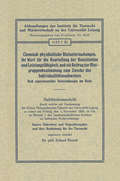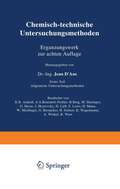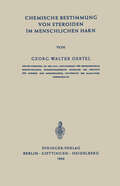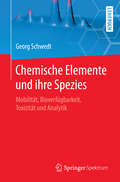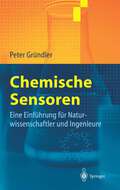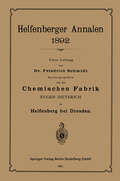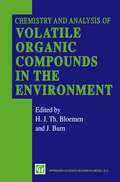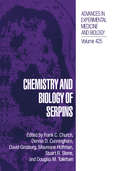- Table View
- List View
Chemikalien und Drogen Teil C: T–Z (Handbuch der Pharmazeutischen Praxis - Vollständige (4.) Neuausgabe #6 / C)
by Paul Heinz List Ludwig HörhammerChemisch-physikalische Blutuntersuchungen, ihr Wert für die Beurteilung der Konstitution und Leistungsfähigkeit, und ein Beitrag zur Blutgruppenbestimmung zum Zwecke des Individualitätsnachweises: Nach experimentellen Untersuchungen am Rinde (Abhandllungen des Instituts für Rierzucht und Milchwirtschaft an der Universiät Leipzig #21)
by Erhard BerndtDieser Buchtitel ist Teil des Digitalisierungsprojekts Springer Book Archives mit Publikationen, die seit den Anfängen des Verlags von 1842 erschienen sind. Der Verlag stellt mit diesem Archiv Quellen für die historische wie auch die disziplingeschichtliche Forschung zur Verfügung, die jeweils im historischen Kontext betrachtet werden müssen. Dieser Titel erschien in der Zeit vor 1945 und wird daher in seiner zeittypischen politisch-ideologischen Ausrichtung vom Verlag nicht beworben.
Chemisch-technische Untersuchungsmethoden Ergänzungswerk zur achten Auflage: Erster Teil Allgemeine Untersuchungsmethoden
by K.R. Andreß A.A. Benedeti-Pichler R. Berg M. Haitinger G. Hesse J. Heyrovský H. Lieb F. Löwe H. Mann W. Meidinger G. Reinäcker H. Siebert K. Wagenmann A. Winkel K. WüstDieser Buchtitel ist Teil des Digitalisierungsprojekts Springer Book Archives mit Publikationen, die seit den Anfängen des Verlags von 1842 erschienen sind. Der Verlag stellt mit diesem Archiv Quellen für die historische wie auch die disziplingeschichtliche Forschung zur Verfügung, die jeweils im historischen Kontext betrachtet werden müssen. Dieser Titel erschien in der Zeit vor 1945 und wird daher in seiner zeittypischen politisch-ideologischen Ausrichtung vom Verlag nicht beworben.
Chemische Biologie: und Wirkstoffentwicklung
by Marco F. SchmidtIm Zentrum dieses Lehrbuchs steht die Anwendung, weniger die die reine Wissensvermittlung der Ergebnisse aller chemisch biologischer Arbeiten (was auch den Rahmen eines Buches sprengen würde). Es gibt dem Leser durch die gezielte Auswahl von chemisch-biologischen Techniken und Konzepten das nötige Rüstzeug, um in dem komplexen Spannungsfeld der Chemischen Biologie und der Wirkstoffentwicklung neue Denkweisen und damit neue Therapiemöglichkeiten entwickeln zu können. Erklärtes Ziel dieses Buches ist es, Studenten, (Post-)Doktoranden sowie erfahrenen Wissenschaftlern an Universitäten sowie in der Industrie bei ihren Problemen konkret Lösungen aufzuzeigen und sie zu inspirieren. Als roter Faden dieses Buches dienen nach einer Einführung in die Problematik, die die Chemische Biologie in der Wirkstoffentwicklung adressiert, die drei Ebenen des molekularbiologischen Dogmas: DNA, RNA und Proteine und ihre Rolle als Wirkstoffziele.
Chemische Elemente und ihre Spezies: Mobilität, Bioverfügbarkeit, Toxizität und Analytik
by Georg Schwedt Wolfgang ZettlmeierDas Buch stellt Methoden und Strategien zur differenzierten Analytik und Bewertung von chemischen Elementen in Wasser, Boden und Lebensmitteln vor zum Zwecke der Bewertung von Mobilität, Toxizität und Bioverfügbarkeit. Denn es ist eben nicht nur die Dosis, die ein Gift zum Gift macht, sondern auch die Art der Spezies.
Chemische Sensoren: Eine Einführung für Naturwissenschaftler und Ingenieure
by Peter GründlerDie Forschung und Anwendungsentwicklung in dem Bereich chemischer und biochemischer Sensoren ist weiterhin in einem schnellen Wachstum begriffen. Die Erfahrungen des letzten Jahrzehnts haben jedoch gezeigt, dass die erfolgreiche Entwicklung solcher Sensoren, die auch den harten Routinebedingungen in den vielfältigen Anwendungsgebieten widerstehen, nur dann möglich ist, wenn Chemiker und Ingenieure kooperieren. Daher ist es das Ziel dieses Lehrbuches, sowohl Chemikern als auch Ingenieuren, Lebensmittel- und Biotechnologen in einer streng systematischen aber sehr praxisorientierten Darstellung die Technologie und die Anwendung chemischer Sensoren nahezubringen.Der interdisziplinäre Ansatz überbrückt die unterschiedlichen Denkweisen in Chemie, Physik und Ingenieurwissenschaften erfolgreich.
Chemische Struktur und Reaktionsmechanismus der Cytochromoxydase (Sitzungsberichte der Heidelberger Akademie der Wissenschaften #1966 / 2)
by M. Rudolf LembergChemisches Praktikum für Mediziner (Studienbücher Chemie)
by Gerhard Hilt Peter RinzeDas Chemische Praktikum stellt für Studierende der Medizin und der Zahnmedizin einen wichtigen Abschnitt in ihrer vorklinischen Ausbildung dar. In ihm werden praktische Kenntnisse über experimentelles Arbeiten vermittelt. Die Versuche umfassen chemische Umsetzungen und analytische Verfahren, die die Grundlagen biochemischer und physiologischer Laborarbeiten bilden. Gleichzeitig führt die praktische Beschäftigung mit der Chemie auch zur Vertiefung der in Vorlesungen und Übungen erarbeiteten theoretischen Kenntnisse. In 65 Aufgaben an elf Kurstagen werden Gesetze und Modellvorstellungen der Chemie exemplarisch erarbeitet. Dabei wird auch auf den sicheren Umgang mit Gefahrstoffen und deren Entsorgung aus der Sicht der Gefahrstoffverordnung und des Umweltschutzes eingegangen.
Chemisches Praktikum für Mediziner
by Dozent Wilhelm HurkaDieser Buchtitel ist Teil des Digitalisierungsprojekts Springer Book Archives mit Publikationen, die seit den Anfängen des Verlags von 1842 erschienen sind. Der Verlag stellt mit diesem Archiv Quellen für die historische wie auch die disziplingeschichtliche Forschung zur Verfügung, die jeweils im historischen Kontext betrachtet werden müssen. Dieser Titel erschien in der Zeit vor 1945 und wird daher in seiner zeittypischen politisch-ideologischen Ausrichtung vom Verlag nicht beworben.
Chemisches Praktikum für Mediziner
by Wilhelm HurkaDieser Buchtitel ist Teil des Digitalisierungsprojekts Springer Book Archives mit Publikationen, die seit den Anfängen des Verlags von 1842 erschienen sind. Der Verlag stellt mit diesem Archiv Quellen für die historische wie auch die disziplingeschichtliche Forschung zur Verfügung, die jeweils im historischen Kontext betrachtet werden müssen. Dieser Titel erschien in der Zeit vor 1945 und wird daher in seiner zeittypischen politisch-ideologischen Ausrichtung vom Verlag nicht beworben.
Chemistry: An Introduction For Medical And Health Sciences
by Alan JonesChemistry: An Introduction for Medical and Health Sciences provides students and practitioners with a clear, readable introduction to the chemical terms and concepts that are relevant to their study and practice. Assuming little prior knowledge of the subject the book describes and explains the chemistry underlying many of the most commonly prescribed drugs and medicines. It also includes information on chemical aspects of digestion and nutrition, oxidation, radioactivity and an overview of how chemicals fight disease. Excellent pedagogy including learning objectives, diagnostic tests and questions in each chapter and a comprehensive glossary Experienced author team with many years experience of teaching chemistry to non-chemists
Chemistry and Analysis of Volatile Organic Compounds in the Environment
by H. J. Bloemen J. BurnInterest in the occurrence and behaviour of volatile organic compounds (VOCs) is increasing due to their adverse effects on the environment and human health. It is essential that information is made available on the various aspects of research on VOCs to enable better understanding and control of the various environmental and human health threats. The information in this book will be used to improve communication and understanding of the various approaches. In particular the potential and limitations of the described analytical methods will be essential in defining environmental studies and interpreting the results.
The Chemistry and Applications of Sustainable Natural Hair Products (SpringerBriefs in Molecular Science)
by Kalyani Barve Apurva DigheThis book investigates the relationship between phytoconstituents and properties in specific plants, such as Hibiscus rosa sinesis, Cuscuta reflexa, Citrullus colocynthis, Nardostachys jatamansi and Ocimum gratissimum, that are used in hair care products including shampoos, conditioners, dyes, and oils. It explains the impact of these materials on the growth, structure, appearance, and health of hair. It also explores how the chemistry of certain plants from sustainable sources is exploited for use in hair products and nutraceuticals. Additionally, the authors include information on ingredients used for formulating 'green' hair products that treat common conditions such as canities, dandruff and alopecia.
Chemistry and Biochemistry of Flavoenzymes: Volume I
by Franz MullerChemistry and Biochemistry of Flavoenzymes summarizes the present knowledge of the chemical and physical properties of free flavin, modified flavins occurring in nature, and deazaflavin. This information forms the fundamental basis for understanding the catalytic properties of flavoenzymes. Flavoproteins involved in transport, electron transfer, oxidation, dehydrogenation and hydroxylation reactions are discussed with respect to their biochemical and biophysical properties. The book presents the catalytic mechanisms of the flavoproteins in detail and, where available, three-dimensional structures and molecular biology data are included. The medical aspects of free and protein-bound flavin are also briefly discussed. Chemistry and Biochemistry of Flavoenzymes is an essential reference source for chemists, biochemists, toxicologists, biologists, pharmacologists, and researchers in the pharmaceutical industry.
Chemistry and Biochemistry of Flavoenzymes: Volume I
by Franz MullerChemistry and Biochemistry of Flavoenzymes summarizes the present knowledge of the chemical and physical properties of free flavin, modified flavins occurring in nature, and deazaflavin. This information forms the fundamental basis for understanding the catalytic properties of flavoenzymes. Flavoproteins involved in transport, electron transfer, oxidation, dehydrogenation and hydroxylation reactions are discussed with respect to their biochemical and biophysical properties. The book presents the catalytic mechanisms of the flavoproteins in detail and, where available, three-dimensional structures and molecular biology data are included. The medical aspects of free and protein-bound flavin are also briefly discussed. Chemistry and Biochemistry of Flavoenzymes is an essential reference source for chemists, biochemists, toxicologists, biologists, pharmacologists, and researchers in the pharmaceutical industry.
Chemistry and Biological Actions of 4-Nitroquinoline 1-Oxide (Recent Results in Cancer Research #34)
by Hideya Endo, Tetsuo Ono and Takashi SugimuraDuring the last decade a considerable body of knowledge has come into existence concerning a class of carcinogenic molecules chiefly represented by 4-nitroquinoline i-oxide. Original papers on this subject are numerous and widely scattered over many branches of science; it was felt that these papers should be reviewed and the knowledge brought together in one volume before it became too unwieldy. This we have attempted to do in this monograph. Our aim has been to include all relevant papers published to date, so that it may serve as an epitome of the present status of knowledge on this important subject. We have been fortunate in securing the cooperation of several colleagues who have contributed chapters, each dealing with one aspect of the subject. We have been doubly fortunate in that these contributors, like ourselves, were at one time or another members of the group belonging to the scientific staff of Dr. WARO NAKA HARA, Director of the National Cancer Center Research Institute, Tokyo, Japan.
The Chemistry and Biology of Isoquinoline Alkaloids (Proceedings in Life Sciences)
by J. D. Phillipson M. F. Roberts M. H. ZenkIsoquinolines form one of the largest groups of plant alkaloids and they in clude a number of valuable clinical agents such as codeine, morphine, eme tine and tubocurarine. Research into different aspects of isoquinolines con tinues in profusion, attracting the talents of botanists, chemists, bioche mists, analysts, pharmacists and pharmacologists. Many of these aspects are of an interdisciplinary nature, and in April 1984, The Phytochemical Society of Europe arranged a 3-day symposium on The Chemistry and Bi ology of Isoquinoline Alkaloids in order to provide a forum for scientists of differing disciplines who are united by a common interest in this one class of natural product. Each chapter in this volume is based on a lecture given at this symposium. Attempts have been made to make the aims and objectives, experimental findings and conclusions reached, intelligible to scientists of differing backgrounds. The introductory chapter, which is mainly based on a historical discus sion, stresses that plants containing isoquinolines have proved to be both a boon and a curse to mankind. The Opium Poppy, Papaver somniferum, produces the medicinally used alkaloids morphine, codeine, noscapine and papaverine whilst it also continues to provide drugs of abuse, particularly morphine and its readily prepared O,O-diacetyl derivative, heroin. Numer ous other alkaloids have been isolated from other members of the Papaver acea, and a knowledge of their presence and distribution within the various species has proved a useful adjunct to systematic botanical studies.
Chemistry and Biology of Pteridines and Folates (Advances in Experimental Medicine and Biology #338)
by June Ayling M. Gopal Nair Charles M. BaughThe pteridines in their multitude of forms fulfill many roles in nature ranging from pigments to cofactors for numerous redox and one-carbon transfer reactions. This extraordinary diversity of function is unified by the unique chemistry of the pteridine heterocycle. The International Symposium on the Chemistry and Biology of Pteridines and Folates is a forum for presenting recent and exciting advances in this expanding field. In of ideas results that has often stimulated bringing together various disciplines, a synergy fresh approaches to major problems. The Tenth International Symposium held at Orange Beach, Alabama, March 21-23, 1993, proved no exception by providing new insights into folate enzymology, tetrahydrobiopterin and molybdopterin biosynthesis and function, enzyme synthesis and regulation, along with novel synthetic strategies for producing compounds that will expedite further study. The many outstanding scientific contributions found in the following chapters, which represent the work presented at the Symposium, are a reflection of the significant advances made since the Ninth International Symposium held in Zurich in 1989. Since the 7th International Symposium in St. Andrews, Scotland, a tradition has evolved of honoring scientists who have made outstanding contributions to pteridine research with a Gowland Hopkins medal and lectureship. Sir Frederick Gowland Hopkins initiated the first investigation of what later proved to be pteridines in his studies of the yellow and white colors of butterflies.
Chemistry and Biology of Pteridines and Folates: Proceedings of the 12th International Symposium on Pteridines and Folates, National Institutes of Health, Bethesda, Maryland, June 17–22, 2001
by Sheldon Milstien Gregory Kapatos Robert A. Levine Barry ShanePteridine and folate research has long been recognized as important for many biological processes, such as amino acid metabolism, nucleic acid synthesis, neurotransmitter synthesis, cancer, cardiovascular function, and growth and development of essentially all living organisms. Defects in synthesis, metabolism and/or nutritional availability of these compounds have been implicated as major causes of common disease processes, e.g. cancer, inflammatory disorders, cardiovascular disorders, neurological diseases, autoimmune processes, and birth defects. Since pteridine and folate biology uses concepts and experimental techniques drawn from all of these disciplines, the breadth of this volume is its great strength, bringing together researchers from a wide variety of fields including biochemistry, chemistry, physics, biophysics, genetics, microbiology, cell and molecular biology, virology, immunology, cancer, neurobiology and medicine. This volume should be a valuable and unique reference work for scientists with interests in these areas as well as those seeking up to date information.
Chemistry and Biology of Serpins (Advances in Experimental Medicine and Biology #425)
by Frank C. Church Dennis D. Cunningham David Ginsburg Maureane R. Hoffman Stuart R. Stone Douglas M. TollefsenProceedings of an International Symposium held in Chapel Hill, North Carolina, April 13-16, 1996

